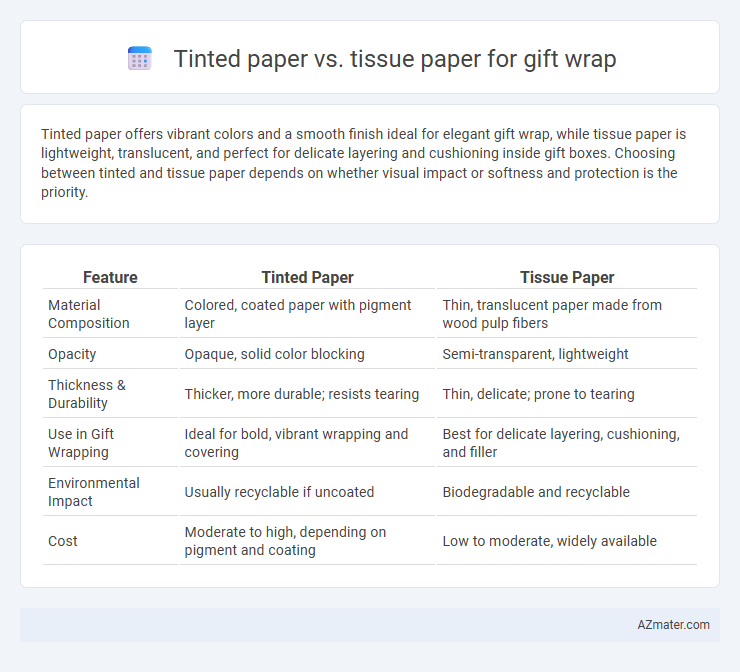Tinted paper offers vibrant colors and a smooth finish ideal for elegant gift wrap, while tissue paper is lightweight, translucent, and perfect for delicate layering and cushioning inside gift boxes. Choosing between tinted and tissue paper depends on whether visual impact or softness and protection is the priority.
Table of Comparison
| Feature | Tinted Paper | Tissue Paper |
|---|---|---|
| Material Composition | Colored, coated paper with pigment layer | Thin, translucent paper made from wood pulp fibers |
| Opacity | Opaque, solid color blocking | Semi-transparent, lightweight |
| Thickness & Durability | Thicker, more durable; resists tearing | Thin, delicate; prone to tearing |
| Use in Gift Wrapping | Ideal for bold, vibrant wrapping and covering | Best for delicate layering, cushioning, and filler |
| Environmental Impact | Usually recyclable if uncoated | Biodegradable and recyclable |
| Cost | Moderate to high, depending on pigment and coating | Low to moderate, widely available |
Overview: Tinted Paper vs Tissue Paper for Gift Wrapping
Tinted paper offers a smooth, glossy finish that enhances the visual appeal of gift wrapping with vibrant colors and a durable surface, making it ideal for elegant presentations. Tissue paper provides a lightweight, translucent texture that adds a delicate, layered effect to gifts, often used for cushioning and decorative purposes. Both materials complement each other by combining sturdiness and softness, allowing versatile and creative wrapping solutions.
Material Composition: What Are They Made Of?
Tinted paper is typically made from wood pulp or recycled paper fibers that are dyed during the manufacturing process to achieve vibrant colors, ensuring durability and smooth texture for wrapping. Tissue paper consists of thin, lightweight sheets made from virgin or recycled wood pulp, often bleached or lightly colored, providing a delicate and soft material ideal for cushioning and decorative purposes in gift wrapping. The fundamental difference in material composition affects their strength, opacity, and tactile feel, with tinted paper being more opaque and sturdy, while tissue paper is semi-transparent and delicate.
Color Vibrancy and Visual Appeal
Tinted paper offers richer color vibrancy due to its dense pigmentation, making gift wraps appear more striking and bold compared to tissue paper. Tissue paper, while softer and more delicate, provides a translucent quality that creates subtle layering effects but often results in colors that are lighter and less intense. For gifts where vividness and strong visual impact are desired, tinted paper is typically the preferred choice over tissue paper.
Texture and Finish Comparison
Tinted paper offers a smooth texture with a consistent, matte or glossy finish that enhances color vibrancy and provides a polished look for gift wrapping. Tissue paper features a delicate, lightweight texture with a slightly crinkled finish, adding a soft, tactile dimension that creates volume and layers without bulk. The choice between tinted and tissue paper impacts the overall presentation, with tinted paper delivering a sleek, modern appearance while tissue paper provides a classic, textured elegance.
Strength and Durability Factors
Tinted paper offers higher strength and durability compared to tissue paper, making it more resistant to tearing and better suited for protecting heavier or bulky gifts. Tissue paper is lightweight and delicate, ideal for adding decorative flair but prone to ripping under stress or when wrapping sharp edges. For long-lasting gift wrap that withstands handling, tinted paper is the superior choice, while tissue paper serves well for aesthetic layering and cushioning.
Ease of Wrapping and Folding
Tinted paper offers a smooth texture and consistent thickness, making it easier to fold crisp and clean edges for gift wrap. Tissue paper is delicate and lightweight, which allows for flexible wrapping but can tear or wrinkle easily during handling. For precision and neatness in wrapping, tinted paper provides superior ease of folding and maintaining shape compared to tissue paper.
Environmental Impact and Sustainability
Tinted paper often contains synthetic dyes and bleaching agents that can contribute to environmental pollution and are less biodegradable than tissue paper, which is typically made from recycled or sustainably sourced fibers. Tissue paper is generally lighter, uses fewer resources in production, and breaks down more easily in composting environments, making it a more sustainable choice for eco-friendly gift wrapping. Choosing tissue paper reduces waste and supports circular sustainability practices by enabling better recycling and minimal chemical impact.
Cost Differences and Affordability
Tinted paper generally costs more than tissue paper due to its thicker material and vibrant color saturation, making it a premium wrapping option. Tissue paper is more affordable and widely available in bulk, ideal for budget-conscious gift wrapping needs. Choosing tissue paper maximizes cost savings without sacrificing presentation quality for everyday gift wrapping.
Suitability for Different Gift Types
Tinted paper offers a smooth, vibrant finish that enhances the presentation of boxed or structured gifts, providing a polished and elegant appearance suitable for luxury items or formal occasions. Tissue paper, with its lightweight and delicate texture, is ideal for wrapping irregularly shaped or fragile gifts, offering cushioning and a soft, decorative touch that complements smaller or delicate items like jewelry and glassware. Choosing between tinted and tissue paper depends on the gift's shape, fragility, and the desired visual effect, ensuring optimal protection and aesthetic appeal.
Final Recommendation: Choosing the Best Gift Wrap
Tinted paper offers vibrant color options and a smooth texture, making it ideal for visually striking gift presentations that require durability and opacity. Tissue paper provides a delicate, lightweight feel suited for layering and adding volume with a soft, translucent finish that complements a variety of gift box styles. For an elegant balance of aesthetics and functionality, tinted paper is recommended for structural wrapping needs, while tissue paper excels as an accent or filler to enhance the overall unwrapping experience.

Infographic: Tinted paper vs Tissue paper for Gift wrap
 azmater.com
azmater.com